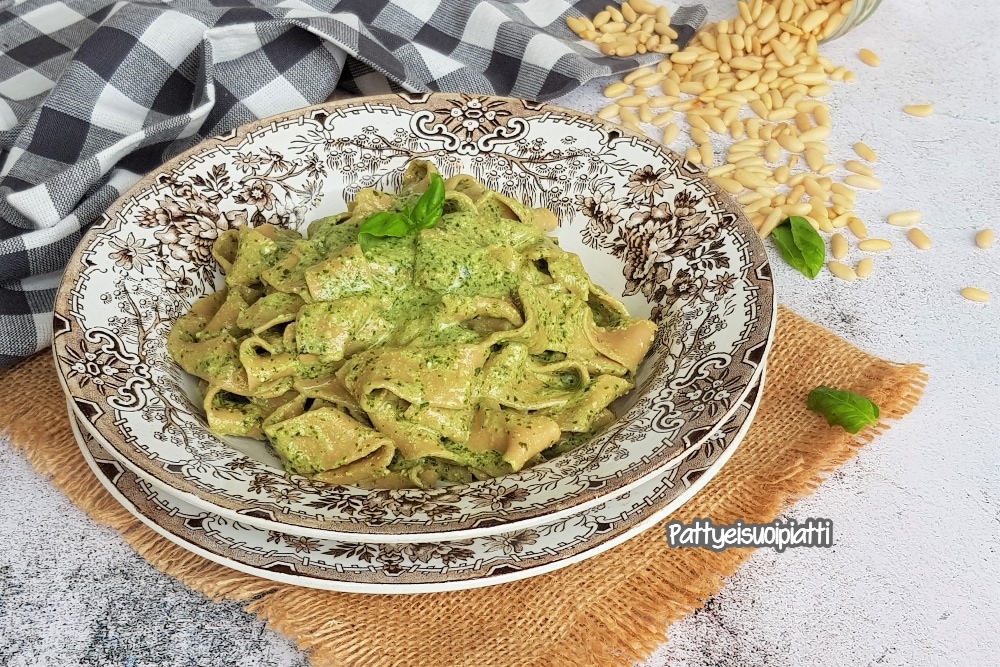The Crazy Picàgge with Pesto and Ricotta are part of the first courses of traditional Ligurian cuisine. They are prepared by mixing all-purpose flour with a portion of chestnut flour, hence the adjective ‘crazy’, and shaped into a tagliatelle about 1.5 cm (0.6 inches) wide, the same width as the cotton tape used to hang kitchen towels, called picàggia in dialect. If you love Genoese recipes, read Genoese Traditional Recipes.
Other Recipes

- Difficulty: Very Easy
- Cost: Economical
- Rest time: 30 Minutes
- Preparation time: 40 Minutes
- Portions: 2 People
- Cooking methods: Stovetop
- Cuisine: Regional Italian
- Region: Liguria
- Seasonality: All Seasons
- Energy 1,072.80 (Kcal)
- Carbohydrates 74.53 (g) of which sugars 6.08 (g)
- Proteins 31.79 (g)
- Fat 75.91 (g) of which saturated 17.48 (g)of which unsaturated 13.69 (g)
- Fibers 6.10 (g)
- Sodium 1,528.36 (mg)
Indicative values for a portion of 372 g processed in an automated way starting from the nutritional information available on the CREA* and FoodData Central** databases. It is not food and / or nutritional advice.
* CREATES Food and Nutrition Research Center: https://www.crea.gov.it/alimenti-e-nutrizione https://www.alimentinutrizione.it ** U.S. Department of Agriculture, Agricultural Research Service. FoodData Central, 2019. https://fdc.nal.usda.gov
Ingredients
- 1 1/4 cups all-purpose flour
- 1/3 cup chestnut flour
- 2 eggs (medium)
- 1/2 tsp salt
- 1 1/2 tbsp semolina (for dusting the work surface)
- 2 oz basil (leaves)
- 1/2 cup extra virgin olive oil
- 1/4 cup pine nuts
- 1 clove garlic
- 1/3 cup Parmigiano Reggiano DOP (grated)
- 1/4 cup Pecorino Sardo (grated)
- 1/2 tsp salt
- 3 1/2 oz ricotta
Tools
- Kitchen Scale
- Work Surface
- Pasta Machine
- Ribbon Cutter
- Immersion Blender
- Bowl
Steps
Sift the flours and place them in a bowl, crack the eggs in the center and add salt. Start to mix and finish the dough on the work surface, form a smooth, uniform ball and let it rest for 30 minutes covered with a cloth. Meanwhile, prepare the pesto.

Wash and dry the basil leaves thoroughly. Place the pine nuts and the garlic (remove the inner core) in a bowl, add the oil, and blend.

Add the basil leaves a few at a time, pulsing the blender at short intervals to avoid heating the blades. Add the grated cheeses, salt, mix, and keep in the fridge until ready to use.

Roll out the dough with a pasta machine to a normal thickness (second to last setting), sprinkle with semolina, and use a ribbon cutter (or fold the dough lengthwise and cut by hand with a knife). The Picàgge should be 1.5 cm (0.6 inches) wide. As they are ready, place them on a surface and sprinkle with semolina.

Bring a pot of water to a boil, add salt and cook the picàgge. They will be ready in just a few minutes, so drain them and place them in a large bowl. Add the ricotta to the pesto, mix and pour over the pasta. Stir, adding a ladle of cooking water, and serve.


